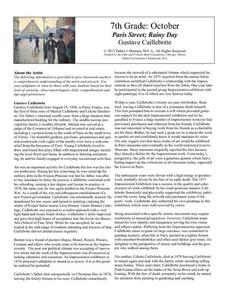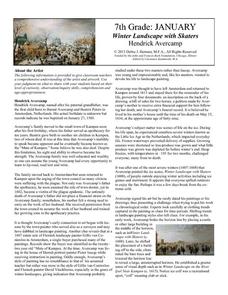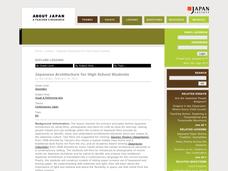University of Chicago
Using Artifacts for Clues About Identity
Learn about the ancient Near East through a close examination of ancient artifacts. Lead your class into analysis by first observing an artifact as a class. Pupils can then work in pairs to analyze the other artifacts and compile a list...
TED-Ed
A Brief History of Religion in Art
Did you know that some languages have no word for art? The English language does and the narrator of this short video discusses the aesthetic dimension of religious art as it "visually communicates meaning beyond language."
Willoughby-Eastlake City Schools
Watercolor Project
Lead your class into watercolor with a well-sequenced plan. Pupils learn about famous watercolorists Winslow Homer and Georgia O'Keeffe and take notes on a presentation about these artists and watercolor techniques. After a teacher...
Ballard & Tighe
Mingle and Match
From Michelangelo and Rembrandt to perspective and apprentice, check out this simple matching activity for your young learners to use when reviewing Renaissance key terms.
Curated OER
"Art History Kites"
Here is a great art activity that can be connected to several different subjects. Kids get creative as they create kites that are inspired by a famous artist or period in art history. They begin the process by choosing their inspiration,...
Curated OER
Medieval Architecture
While this resource is about architecture, it isn't about art. It demonstrates the differences between Romanesque and Gothic architecture to show changes in the socio-political spectrum of the time. Images and good discussion questions...
Debra J. Herman
The Blue Room by Susanne Valadon
Nearly anything can inspire art. Analyze The Blue Room by Susanne Valadon to help your learners understand that art is everywhere. They'll discuss the line, shape, color, and mood of the piece while attempting to better grasp its...
Concordia University Chicago
The Pietá by Michelangelo Buonarroti
Why is arts education so important? It builds critical thinking, analysis and creative problem-solving skills. Learners review the life of Michelangelo Buonarroti, and then analyze his piece, The Pieta. After that, they'll sculpt a human...
Concordia University Chicago
Paris Street; Rainy Day by Gustave Caillebotte
Discuss the balance, color, emotion, and context of the painting Paris Street; Rainy Day by Caillebotte. After a deep discussion, let creativity run free in your class as learners create a dimensional piece that reflects a life change...
Concordia University Chicago
Winter Landscape with Skaters by Hendrick Avercamp
In need of a quick set of ideas to use on a wintery day? Why not analyze Winter Landscape with Skaters with your class? After a thorough discussion, learners compare and contrast two paintings, research what curators do, draw landscapes,...
Concordia University Chicago
Peace and Plenty by George Inness
Learners will need to discuss the Civil War to truly understand the painting Peace and Plenty by George Inness. They'll analyze the painting in terms of context, style, and technique. Then, they'll experiment with light and composition...
Concordia University Chicago
Tahitian Landscape by Paul Gauguin
Get ready to explore the piece Tahitian Landscape with your seventh graders. They discuss the primitive style, bright colors, and impressionism found in the work, as well as biographical information regarding Gauguin's life. There are...
Denver Art Museum
Lesson: High Prestige and Status
Prestige and status have been symbolized in many different ways throughout human history. Young art historians analyze an ancient Panamanian medallion for symbols of prestige and status, and then generate a list of other symbols of...
Denver Art Museum
Lesson: That's Not Natural
Any time kids engage in a design project, they are building problem-solving skills, collaborative learning skills, and creative thinking skills. Upper graders take a nature walk to observe and sketch organic shapes and lines that they...
Santa Ana Unified School District
Frida Kahlo
Before one can understand the work of Frida Kahlo, one needs to understand her life. Provide learners with background information on Frida's life as a person and a painter. The slides then provide information regarding several of her...
Sargent Art
Picasso and Beyond!
After reviewing the life and art of Pablo Picasso, learners set out to create abstract, cubist, relief portraits. They'll draw, color, paint, and cut out portraits just like the ones Picasso created. The instructional activity is...
New Class Museum
Lesson: French Revolution and Visual Language of Power
Take a look at the French Revolution and neo-classic art, then compare it to current social issues and contemporary art. Kids analyze several pieces painted by Jacques-Louis David in regard to style and subject then compare them to...
Japan Society
Japanese Architecture for High School Students
Japanese architecture is rich in symbolism and culture. Critical thinkers engage in three activities intended to expose them to the beauty of Japan. They read through the book, Praise of Shadows by Junichiro Tanizaki and watch the film...
Curated OER
The Age of Confusion
According to the presentation, the age of confusion was marked by a very specific set of art and philosophical movements. Take a visual trip, and explore expressionism, cubism, Dada, Bauhaus, existentialism, and the new modes of...
Curated OER
Aegean Art Cycladic Art 3200-1050 BC, Minoan Art 3000-1100 BC, and Mycenaean Art 1600-1100 BC
So exciting, art from the ancient mediterranean! Get ready to divulge interesting facts about the art and culture of the Minoans, Mycenaeans, Aegeans, and Cycladians. Each slide provides a map, images of art, and the cultural...
Curated OER
Roman Art, Architecture, and Engineering
There is no better tool to help you explain art or architecture than an image-filled slide show. Classic Greek art, architecture, and engineering are all described with excellent visual examples and text which defines each form by its...
Curated OER
Byzantine Art: 5th century to 1453 AD
Art and architecture are great ways to help define historical periods and cultural norms. Take a critical look at the art of the Byzantine period as seen under Justinian rule. Iconography, vocabulary, religious, and political concepts...
Curated OER
Lesson: A Collage of Cultures
The blanket being analyzed here seems simple and plain, but it reflects the culture and geography of the people who made it. Learners critically examine the influence geography and culture had on the creation of the blanket and on...
Curated OER
Lesson: The Gift of Giving
Giving gifts has been a part of the human experience since modern man walked the earth. Upper graders explore the culture of gift giving in Mayan times through an artistic analysis. They analyze gift giving and palace life as seen on an...

























